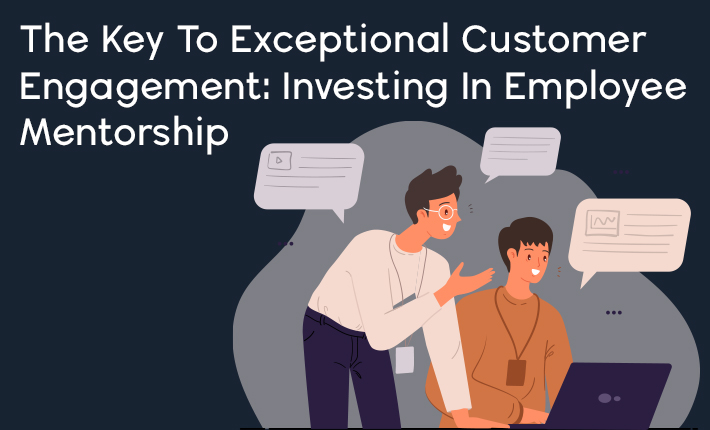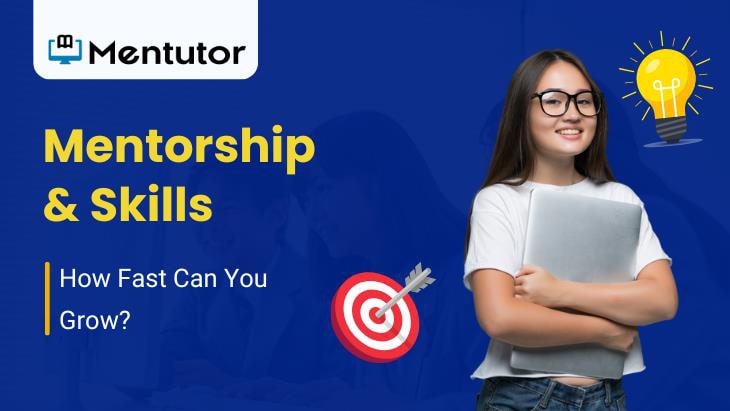Introduction
In today's highly competitive business environment, organizations are constantly seeking innovative ways to enhance customer engagement and loyalty. While many may focus on improving technology or marketing strategies, one often overlooked aspect is the importance of employee mentorship. Investing in mentorship programs within your company can not only boost employee satisfaction and retention but also have a profound impact on customer engagement. This article will discuss how fostering a culture of mentorship can lead to exceptional customer service, increased customer loyalty, and ultimately, a thriving business. By recognizing the significance of investing in employee mentorship, businesses can establish a successful foundation for long-term success in the ever-evolving landscape of customer engagement.
The Power of Employee Mentorship
Employee mentorship has become an integral part of many organizations' corporate culture. Recognizing the power and value of guiding and nurturing new talent, companies have started investing in formal mentorship programs. The benefits of employee mentorship extend beyond just career development and personal growth; it also fosters a positive work environment and promotes a culture of continuous learning.
What is Employee Mentorship?
Employee mentorship refers to a professional relationship between a more experienced employee or mentor and a less experienced employee or mentee. It involves providing guidance, support, and knowledge transfer to help the mentee develop their skills, knowledge, and career prospects. Mentorship programs are often implemented within organizations to foster personal and professional growth, improve job performance, and enhance employee retention. Mentors offer valuable insights, share experiences, and provide constructive feedback to mentees, helping them navigate their career paths and overcome challenges. Employee mentorship creates a culture of learning, collaboration, and continuous development within the organization, benefiting both mentors and mentees.
Benefits of Employee Mentorship
Employee mentorship programs provide numerous benefits to both the mentees and the mentors. This article explores the advantages of implementing employee mentorship program in organizations.
Firstly, employee mentorship programs help in the professional development of the mentees. Mentees get the opportunity to learn from experienced professionals and receive guidance on their career paths. This mentoring relationship allows mentees to gain new skills, knowledge, and insights that contribute to their growth within the company.
Secondly, mentorship programs foster a positive work culture. Mentors become role models for their mentees, inspiring them to perform better and strive for success. The mentorship relationship creates a sense of trust, respect, and loyalty within the organization, leading to increased engagement and employee retention.
Moreover, these programs contribute to knowledge transfer within the organization. Mentors impart their expertise, industry insights, and best practices to their mentees, resulting in the dissemination of knowledge and skills throughout the company.
Furthermore, employee mentorship programs promote diversity and inclusion. Mentors can support and advocate for the career advancement of underrepresented employees, helping to bridge any gaps in opportunities and promoting a more inclusive workforce.
Overall, employee mentorship programs have numerous benefits, including professional development, enhanced work culture, knowledge transfer, and diversity promotion. Implementing these programs can lead to a more engaged, skilled, and diverse workforce, ultimately contributing to the overall success of the organization.
Building a Strong Company Culture
A strong company culture is crucial for the success and growth of any organization. It sets the foundation for employee engagement, productivity, and loyalty. This article explores the importance of building a strong company culture and provides practical tips for creating and nurturing it.
The article highlights how a positive company culture can attract and retain top talent, leading to higher levels of motivation and satisfaction among employees. It delves into the elements that contribute to a strong culture, such as a clear mission and values, effective communication, and employee recognition. It also emphasizes the role of leadership in fostering a positive culture.
Furthermore, the article offers actionable strategies for building a strong company culture, including promoting work-life balance, encouraging teamwork and collaboration, and fostering a supportive and inclusive environment. It also discusses the significance of regularly evaluating and adapting the culture to meet evolving needs.
Overall, the article provides valuable insights and practical guidance for organizations looking to strengthen their company culture to drive success and create a positive and fulfilling work environment.
Gaining a Competitive Edge
Gaining a competitive edge refers to the strategies and actions taken by a company to differentiate itself from its competitors and attract more customers. It involves analyzing the market, identifying market gaps and needs, and developing unique products or services that meet those needs better than the competition. Gaining a competitive edge can also involve enhancing operational efficiency, improving customer service, or implementing innovative marketing strategies. This allows a company to stand out from the crowd, increase its market share, and ultimately achieve higher profitability.
Improving Productivity
Improving productivity is crucial for any business to remain competitive and maximize profits. It involves streamlining processes, eliminating waste, and utilizing resources effectively. Increasing productivity can lead to cost savings, faster delivery times, and higher customer satisfaction. Implementing technologies, providing training, and promoting collaboration among employees are often key drivers in improving productivity.
Boosting Customer Loyalty
Boosting customer loyalty is essential for the long-term success of any business. Loyal customers not only continue to purchase from a company but also become advocates, referring their friends and family. Providing exceptional customer service, personalized experiences, and consistently delivering high-quality products or services are ways to build customer loyalty. Additionally, loyalty programs, rewards, and discounts can incentivize repeat business and foster a sense of appreciation and value among customers. Overall, customer loyalty leads to increased customer retention, higher sales, and positive word-of-mouth, which ultimately contributes to the company's growth and profitability.
Nurturing Mentorship Programs
Nurturing mentorship programs focus on providing support and guidance to individuals in order to help them achieve their goals and succeed in their personal and professional lives. Setting clear goals is a vital aspect of these programs, as it allows both the mentor and mentee to have a shared understanding of what they want to accomplish. Clear goals provide direction and motivation for the mentorship relationship, ensuring that both parties are working towards a common purpose.
Providing Resources
Providing resources is another key component of nurturing mentorship programs. Mentors can leverage their experience and expertise to offer valuable resources such as training materials, industry insights, and networking opportunities. By providing these resources, mentors empower their mentees with the tools and knowledge they need to overcome challenges and achieve their objectives.
Measuring Success
Measuring success is an essential part of nurturing mentorship programs as it allows for the evaluation and improvement of the program's effectiveness. By establishing measurable metrics and regularly assessing progress, mentorship programs can identify areas for improvement and adjust their strategies accordingly. Measuring success also provides a sense of accomplishment and motivation for both mentors and mentees, as they can witness the positive impact of their efforts and celebrate their achievements.
Overall, nurturing mentorship programs that focus on setting clear goals, providing resources, and measuring success create an environment where individuals can flourish
Overcoming Challenges
Resistance to Change
Introducing mentorship programs may face resistance from employees accustomed to traditional structures. Open communication and transparency can help address these concerns.
Time and Resource Constraints
Finding time for mentorship can be challenging, especially in busy organizations. However, the long-term benefits far outweigh the initial investment.
The Future of Employee Mentorship
The future of employee mentorship is likely to see significant changes in its approach and utilization due to two main factors: adaptation to remote work and the integration of artificial intelligence (AI) in mentorship programs.
Adaptation to Remote Work
As remote work continues to gain popularity and becomes the norm for many organizations, the traditional face-to-face mentorship model will need to adapt. Virtual mentorship programs, using technologies such as video conferencing and online collaboration tools, will enable employees to connect with mentors regardless of their physical location. This will open up a wider range of mentorship opportunities and create a more flexible and inclusive environment for employees.
AI and Mentorship
The integration of AI in mentorship programs has the potential to enhance and personalize the learning experience for employees. AI can analyze data and provide personalized recommendations to employees, based on their skills, goals, and areas for improvement. It can also facilitate matchmaking between mentors and mentees based on their shared interests and objectives. In addition, AI-powered virtual assistants can provide on-demand guidance and support to employees, supplementing the role of human mentors.
Overall, the future of employee mentorship will likely see a shift towards virtual mentorship programs and the integration of AI to enhance personalization and accessibility, ultimately leading to more effective and impactful mentorship experiences.
Implementing Mentorship in Your Organization
Implementing mentorship in an organization involves the creation and execution of a structured program where experienced employees, or mentors, provide guidance and support to less experienced employees, or mentees, in their professional development and career advancement. This program aims to facilitate the transfer of knowledge, skills, and perspectives from mentors to mentees, fostering personal growth and growth within the organization.
To implement mentorship effectively, the organization needs to establish clear objectives and expectations for both mentors and mentees, outlining the parameters and duration of the mentorship relationship. A matching process should be implemented, pairing mentees with mentors who have relevant expertise and experience.
Regular meetings should be scheduled between mentors and mentees to discuss goals, progress, and challenges. These meetings can take the form of one-on-one sessions, group workshops, or even informal networking events.
Furthermore, the organization should provide resources and training to mentors, equipping them with the necessary skills to guide and support their mentees effectively. Regular monitoring and evaluation of the mentorship program are also essential to ensure its ongoing success and identify areas for improvement.
Implementing mentorship in an organization can lead to numerous benefits, such as increased employee engagement, enhanced professional growth, improved retention rates, and a more collaborative and knowledge-sharing culture.
Measuring Customer Engagement
Implementing mentorship in an organization involves several key steps to ensure its success.
In the first step, "Identifying Mentors and Mentees" organizations need to identify potential mentors who have the necessary skills, experience, and willingness to support others. They can look for individuals with strong leadership qualities and expertise in specific areas. Similarly, mentees can be identified based on their career goals, aspirations, and areas for growth. Clear criteria should be established to match mentors and mentees effectively, considering factors such as compatibility and shared interests.
The second step, "Training and Support" is crucial in preparing both mentors and mentees for their roles. Mentorship training programs should be designed to provide mentors with the necessary skills, such as active listening, effective feedback, and goal setting, while mentees should be educated on how to actively engage with their mentors and set realistic expectations. Ongoing support should also be provided, such as regular check-ins and access to resources, to ensure the mentorship relationship remains productive.
The final step, "Continuous Improvement" emphasizes the need for organizations to regularly evaluate and improve their mentorship programs. This can be done through feedback surveys or focus groups with mentors and mentees to gather insights on their experience and identify areas for improvement. Organizations should also
The Holistic Approach
In the holistic approach to mentorship, two important factors are aligning mentorship with business goals and integrating it with HR strategies.
Aligning mentorship with business goals means that the mentorship program is designed and implemented in a way that supports and furthers the goals and objectives of the organization. This requires a clear understanding of the organization's priorities and how mentorship can contribute to them. For example, if the goal of the organization is to cultivate future leaders, the mentorship program may focus on developing leadership skills and providing guidance and support to high-potential employees.
Integration with HR strategies involves incorporating mentorship into the overall HR strategy of the organization. This means that mentorship is not seen as a standalone program, but rather as an integral part of the employee development and talent management process. HR strategies such as performance management, succession planning, and talent acquisition can be aligned and enhanced by incorporating mentorship as a tool for employee growth and development.
By aligning mentorship with business goals and integrating it with HR strategies, organizations can ensure that mentorship programs are effective, impactful, and contribute to the overall success of the organization.
The Road to Success
Consistency and patience are two essential factors on the road to success. Consistency implies unwavering dedication and commitment towards one's goals. It involves persistently putting in effort, even when faced with obstacles or setbacks. By consistently working towards our objectives, we increase our chances of achieving them.
Patience is the ability to endure and persevere while waiting for desired outcomes. Success rarely happens overnight; it requires time and effort. It is crucial to understand that progress may be slow and that setbacks are a part of the journey. Being patient allows us to learn from our mistakes, reassess our strategies, and continue moving forward.
Additionally, celebrating achievements is equally important. Recognizing and acknowledging our progress not only instills a sense of accomplishment but also motivates and inspires us to keep going. Celebrations can take various forms and can be personalized according to individual preferences. It could be as simple as treating oneself to a favorite meal, sharing the achievement with loved ones, or taking a well-deserved break.
Overall, consistency and patience are the building blocks of success. By staying consistent, maintaining patience, and celebrating our achievements along the way, we are more likely to reach our goals and experience fulfillment and satisfaction in our journey.
Conclusion
In conclusion, investing in employee mentorship is the key to exceptional customer engagement. By fostering growth, empowering employees, and building a culture of learning, mentorship programs provide organizations with a competitive advantage in today's dynamic business landscape.
FAQs
Q1. How can I start an employee mentorship program in my organization?
Begin by identifying potential mentors and mentees, establish clear goals, and allocate necessary resources.
Q2. What metrics should I track to measure customer engagement?
Key metrics include NPS, CSAT, and customer retention rates.
Q3. How do I overcome resistance to change when introducing mentorship programs?
Open communication, transparency, and showcasing success stories can help address resistance.
Q4. Are there tools that can assist with remote mentorship programs?
Yes, various digital tools and platforms facilitate remote mentorship.
Q5. What role does AI play in employee mentorship?
AI can provide data-driven insights and personalized recommendations to enhance mentorship programs.
Unlock the potential of your organization's customer engagement by investing in employee mentorship. It's a strategy that not only benefits your employees but also leaves a lasting positive impression on your valued customers.






Leave a reply